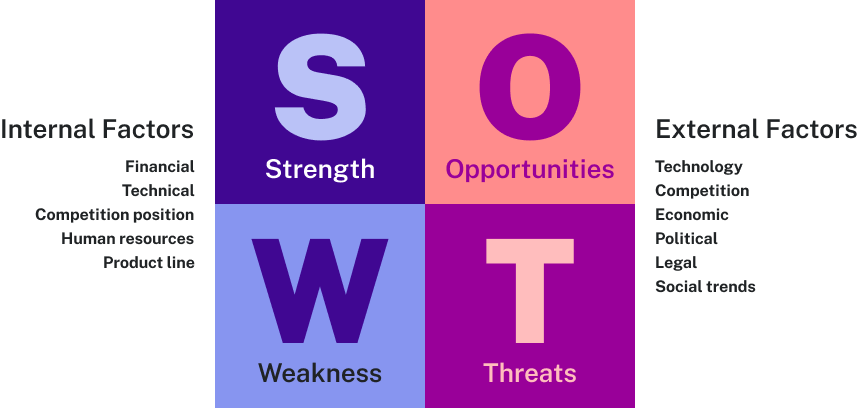SWOT Analysis
One of the key planning tools managers have at their disposal is the situation analysis, or SWOT analysis. SWOT stands for strengths, weaknesses, opportunities, and threats. Conducting such an analysis provides a means of projecting expectations, anticipating problems, and guiding decision making. A SWOT analysis is an examination of the internal and external factors that impact the organization and its plans.

External factors include opportunities and threats that are outside of the organization. These are factors that the company may be able to influence—or at least anticipate—but not fully control. Examples of external factors are technology innovations and changes, competition, economic trends, government policies and regulations, legal judgments, and social trends.
The internal factors include strengths and weaknesses within the organization currently. Examples of internal factors are financial resources, technical resources and capabilities, human resources, and product lines. Since the company has the most control over internal factors, it can develop strategies and objectives to exploit strengths and address weaknesses.
Why SWOT Matters
The benefit of a SWOT analysis is that it gives managers a clear picture of the “situation” in which it operates and helps them develop realistic plans. Managers must continually scan the internal and external business environment for signs of change that may require alterations to their plans. The organization’s strengths and weaknesses evolve over time, and new threats and opportunities can appear out of the blue. Ignoring signals that technology, consumer demands, resource availability, or legal requirements are changing can leave the business in an inferior position relative to the competition and can very well mean the end of the business. For this reason, effective managers should use SWOT analysis as a tool to inform decision making and planning on a regular basis.
You can see how pervasive planning is within a business and that plans can range from the broad and general (as with the strategic plan, for example) to the narrow and specific (as with operational plans). Each type of plan is important to the overall success of an organization. Furthermore, planning is crucial to fulfilling the other functions of management. Without plans, effective organizing, leading, and controlling won’t happen. Failure to plan—or postponing it—can be a real liability for labor-oriented, hands-on managers.